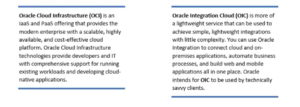As we all know, adoption rates of software as a service, or simply SaaS, have increased massively over time. We’re using cloud applications more and more. SaaS adoption is growing because it is simple and easier than deploying on-premise software. You need a faster way to integrate your new SaaS applications with your existing and on-premise ones.
Cloud integration does exactly that. You want to integrate your applications in minutes, not months. So, what exactly is Oracle Integration Cloud? All the questions will be answered as we try to demystify OIC while discussing why we need OIC, which components does OIC have so on so forth.
What is OIC?
Oracle Integration Cloud Service is a comprehensive, secure, lightweight integration solution that allows you to connect your cloud-based applications. It simplifies connectivity between your applications and can connect your cloud-based and on-premises applications.
What it means is that if you have an application that is running on-premise and you also have an application whose data is stored on the cloud, and you want to have an application that can collect data from both applications, OIC makes it easier for you. OIC combines all application integration, process automation, visual application building, and integration analytics capabilities into a single unified cloud service.
But why OIC?
Cloud integration solutions were developed to eliminate data silos, improve connectivity and visibility, and, ultimately, optimize business processes. Data integration tools were developed in response to the need to share data between cloud-based applications and unify information components.
Cloud integration is becoming more popular as the use of Software as a Service (SaaS) solutions grows. According to studies, more than 90% of enterprises use a multi-cloud strategy, and SaaS usage will soon outpace traditional product delivery.
Furthermore, as more businesses use a hybrid mix of SaaS and on-premises applications, the demand for progressive cloud data integration methods grows.
What is the difference between OIC and OCI?
As you all may be aware, Oracle Cloud is a new cloud computing platform that provides a wide range of services, such as computing, storage, application development, and networking. Oracle has grown from a small database company to a dominant player in the Cloud market in the last 30 years. With its wide range of services, it has satisfied millions of customers.
But before we move ahead, many people are confused by the terms “Oracle Integration Cloud” and “Oracle Cloud Infrastructure”. So here is the difference.

What are the main components of OIC?
Mainly, Oracle Integration Cloud consists of three parts. They work together to provide a set of solutions for designing business processes, integrations, orchestrations, and web/mobile applications. If you prefer, you can use each one separately. These are:
- Process Builder
- Integration
- Visual Builder
- Let’s explore each
Process Builder:
A process builder is made to design your business processes with a friendly interface and no coding. You can also use the platform to carry out process-related activities such as task approvals, monitoring, and reporting. It gives you the raw idea of how your business application will perform and whether it will be user-friendly.
Integration:
The main goal of this tool is to help you design your integrations while using a user-friendly interface. Depending on your mapping and data manipulation complexity, you will need some technical knowledge and coding. You can also use this tool to monitor and manage all of the instances created by your integrations.
Visual Builder:
Visual Builder can be used to create a tool for an application, web or mobile. This tool also allows you to create forms and pages for your processes and integrations. Some coding will be necessary. Oracle JET and Groovy scripting are both supported.
Benefits of OIC:
Oracle Integration Cloud is a unified solution that combines application integration, business process automation, and end-to-end monitoring. OIC keeps you moving so your company can grow.
The benefits are:
- Quick Connections that eliminate time-consuming manual processes
- Simplified User Interface to better understand what you’re dealing with
- Fully equipped applications that can be integrated to get end-to-end monitoring
- A highly secure, scalable platform and available for your most critical integrations.







